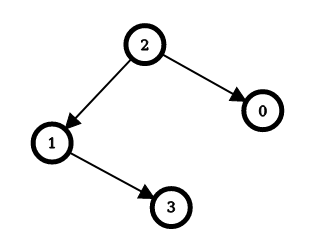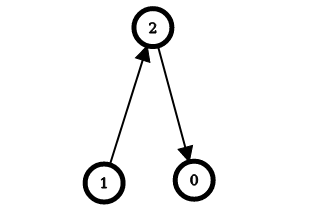2858. Minimum Edge Reversals So Every Node Is Reachable
Description
There is a simple directed graph with n nodes labeled from 0 to n - 1. The graph would form a tree if its edges were bi-directional.
You are given an integer n and a 2D integer array edges, where edges[i] = [ui, vi] represents a directed edge going from node ui to node vi.
An edge reversal changes the direction of an edge, i.e., a directed edge going from node ui to node vi becomes a directed edge going from node vi to node ui.
For every node i in the range [0, n - 1], your task is to independently calculate the minimum number of edge reversals required so it is possible to reach any other node starting from node i through a sequence of directed edges.
Return an integer array answer, where answer[i] is the minimum number of edge reversals required so it is possible to reach any other node starting from node i through a sequence of directed edges.
Example 1:
Input: n = 4, edges = [[2,0],[2,1],[1,3]] Output: [1,1,0,2] Explanation: The image above shows the graph formed by the edges. For node 0: after reversing the edge [2,0], it is possible to reach any other node starting from node 0. So, answer[0] = 1. For node 1: after reversing the edge [2,1], it is possible to reach any other node starting from node 1. So, answer[1] = 1. For node 2: it is already possible to reach any other node starting from node 2. So, answer[2] = 0. For node 3: after reversing the edges [1,3] and [2,1], it is possible to reach any other node starting from node 3. So, answer[3] = 2.
Example 2:
Input: n = 3, edges = [[1,2],[2,0]] Output: [2,0,1] Explanation: The image above shows the graph formed by the edges. For node 0: after reversing the edges [2,0] and [1,2], it is possible to reach any other node starting from node 0. So, answer[0] = 2. For node 1: it is already possible to reach any other node starting from node 1. So, answer[1] = 0. For node 2: after reversing the edge [1, 2], it is possible to reach any other node starting from node 2. So, answer[2] = 1.
Constraints:
2 <= n <= 105edges.length == n - 1edges[i].length == 20 <= ui == edges[i][0] < n0 <= vi == edges[i][1] < nui != vi- The input is generated such that if the edges were bi-directional, the graph would be a tree.
Solutions
Solution 1
1 2 3 4 5 6 7 8 9 10 11 12 13 14 15 16 17 18 19 20 21 22 23 24 | |
1 2 3 4 5 6 7 8 9 10 11 12 13 14 15 16 17 18 19 20 21 22 23 24 25 26 27 28 29 30 31 32 33 34 35 36 37 38 | |
1 2 3 4 5 6 7 8 9 10 11 12 13 14 15 16 17 18 19 20 21 22 23 24 25 26 27 28 29 30 31 | |
1 2 3 4 5 6 7 8 9 10 11 12 13 14 15 16 17 18 19 20 21 22 23 24 25 26 27 28 29 30 31 32 33 34 | |
1 2 3 4 5 6 7 8 9 10 11 12 13 14 15 16 17 18 19 20 21 22 23 24 25 26 27 | |




